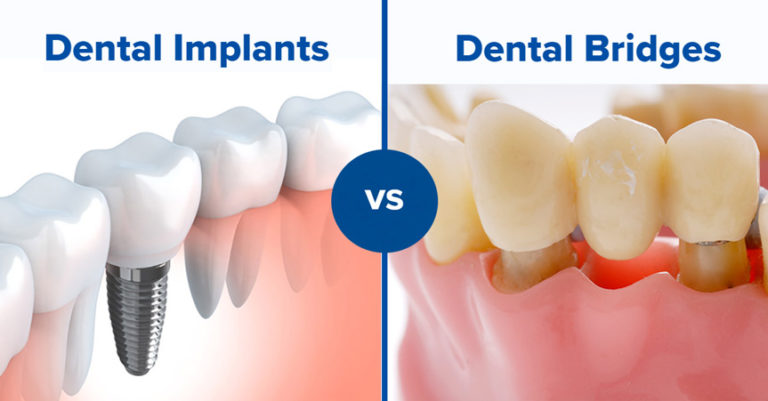Losing a tooth can affect more than just your smile. It can change how you chew, impact the alignment of your other teeth, and even affect your confidence. Fortunately, modern dentistry offers excellent solutions to replace missing teeth and restore your smile’s function and appearance. Two of the most popular and effective options are dental implants and bridges.
While both can fill the gap left by a missing tooth, they work in very different ways. Understanding the key differences, benefits, and considerations for each will help you and your dentist decide which solution is the right fit for your unique situation. Let’s break down dental implants and bridges to see how they compare.

What is a Dental Bridge?
A dental bridge is a traditional and time-tested method for replacing one or more missing teeth. As the name suggests, it “bridges” the gap by anchoring a false tooth (called a pontic) to the natural teeth on either side of the space. These adjacent teeth, known as abutment teeth, are prepared by having some of their enamel removed to make room for crowns. The crowns are then placed over the abutment teeth, with the pontic fused between them to create a single, solid unit.
The Pros of Dental Bridges
- Faster, Less Invasive Process: Getting a dental bridge is typically a quicker process than getting an implant, often completed in just two or three visits. The procedure is also non-surgical, which can be appealing for many patients.
- Cost-Effective Upfront: Initially, the cost of a dental bridge is often lower than that of a dental implant, which can make it a more accessible option for some budgets.
- Excellent Aesthetics: Bridges are custom-made to match the color and shape of your natural teeth, providing a seamless and natural-looking restoration.
The Cons of Dental Bridges
- Impacts Adjacent Teeth: The biggest drawback of a bridge is the need to alter healthy teeth. To place the supporting crowns, your dentist must permanently remove enamel from the neighboring teeth, making them more vulnerable to future decay or sensitivity.
- Shorter Lifespan: Dental bridges typically last between 5 and 15 years. They may need replacement over time due to wear and tear or issues with the supporting teeth.
- Bone Loss: Because a bridge sits on top of the gums, it does not stimulate the jawbone underneath the missing tooth. Over time, this can lead to bone deterioration in that area.
What is a Dental Implant?
A dental implant is a modern solution that replaces the entire tooth structure, from root to crown. It consists of three parts: a small, titanium post that is surgically placed into the jawbone to act as a new root; an abutment that connects the post to the new tooth; and a custom-made crown that sits on top. The titanium post fuses with the jawbone over several months in a process called osseointegration, creating a strong and stable foundation.
The Pros of Dental Implants
- Preserves Healthy Teeth: Implants are standalone solutions. They do not require any support from adjacent teeth, leaving your healthy tooth structure completely intact.
- Long-Lasting and Durable: With proper care, dental implants can last a lifetime. They are designed to be a permanent solution for tooth loss.
- Prevents Bone Loss: By acting as an artificial tooth root, the implant stimulates the jawbone, preventing the bone deterioration that naturally occurs when a tooth is lost.
- Feels and Functions Like a Natural Tooth: Because it’s securely anchored in your jaw, an implant looks, feels, and functions just like one of your natural teeth, with no restrictions on what you can eat.
The Cons of Dental Implants
- Surgical Procedure: Placing an implant requires a surgical procedure, which involves a longer healing and treatment timeline compared to a bridge.
- Higher Initial Cost: The upfront investment for a dental implant is generally higher than for a bridge. However, its longevity can make it more cost-effective in the long run.
- Requires Sufficient Bone Density: A successful implant requires a healthy and adequate amount of jawbone to fuse with. Patients with significant bone loss may need a bone graft before they can receive an implant.
Making the Right Choice for Your Smile
So, which option is best for you? The answer depends on several factors, including your oral health, the number of missing teeth, your budget, and your long-term goals.
- A dental bridge might be a good option if you are looking for a faster, non-surgical solution and the teeth next to the gap already need crowns.
- A dental implant is often the preferred choice for those seeking a permanent, long-term solution that preserves the health of all surrounding teeth and jawbone.
The best way to determine the right path forward is to consult with a dental professional. A thorough examination will help assess your specific needs and create a personalized treatment plan.
Don’t let a missing tooth hold you back. At Hillside Dental, we are committed to helping you find the perfect solution to restore your smile and confidence. Contact our office on Dyer St. today to schedule a consultation. Regular visits and professional guidance are key to maintaining a lifetime of excellent oral health.
